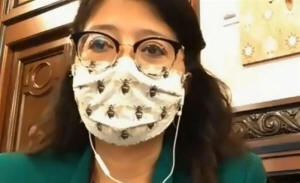Senate panel endorses ‘media literacy’ mandate in schools
 Send a link to a friend
Send a link to a friend
[May 19, 2021]
By PETER HANCOCK
Capitol News Illinois
phancock@capitolnewsillinois.com
 SPRINGFIELD – All high schools in Illinois
would be required to offer instruction in how to understand and evaluate
news and social media as part of their computer literacy courses under a
bill that advanced out of a Senate committee Tuesday. SPRINGFIELD – All high schools in Illinois
would be required to offer instruction in how to understand and evaluate
news and social media as part of their computer literacy courses under a
bill that advanced out of a Senate committee Tuesday.
Sen. Karina Villa, D-West Chicago, argued in the Senate Education
Committee that the bill is needed because vast changes in the media
landscape that have occurred in recent years.
“In the digital age, the internet has become the primary public square,”
she said. “Young people consume, create and share news throughout
digital media. They debate and discuss social issues, politics and civic
issues in online spaces. They’re also vulnerable to persecution and
misinformation.”
During the lame duck session in January, lawmakers passed an education
reform bill backed by the Illinois Legislative Black Caucus that was
aimed at improving racial and ethnic equity in education. That bill,
which Gov. JB Pritzker signed into law in March, included a requirement
that all schools provide “developmentally appropriate” computer literacy
instruction.

Villa said that House Bill 234 would add to that requirement by
including “media literacy” within the definition of computer literacy,
beginning in the 2022-2023 school year.
According to the bill, that would include instruction on accessing
information across various platforms; analyzing and evaluating media
messages; creating their own media messages; and social responsibility
and civics.
But Sen. Terri Bryant, R-Murphysboro, questioned how objective schools
could be in teaching students how to evaluate news stories by separating
factual news from “fake news.”
“What’s fake news and what is not fake news,” she asked.
Villa replied that teachers are trained in how to instruct students in
media usage and that the difference between fake news and real news is
the same as the difference between fiction and nonfiction.
“So the teachers themselves would be deciding what’s fake news, by their
own opinion,” Bryant asked.
She asked hypothetically what would happen if a district decided that
CNN anchor Anderson Cooper was a liar. “They could basically say that
anything Anderson Cooper says is fake news,” Bryant said.
Villa, however, said the instruction would just be designed to teach
students how to verify information in a news story in order to evaluate
for themselves what is accurate and what is not.
The bill passed out of the committee by a vote of 7-2 and now heads to
the floor of the Senate. It previously passed the House, 68-44, on March
20.
[to top of second column]
|

Sen. Karina Villa, D-West Chicago, introduces a bill
to require schools to teach media literacy during a virtual
committee hearing Tuesday. (Credit: Blueroomstream.com)

Seclusion and restraint
The committee also advanced a bill that would require the Illinois
State Board of Education to adopt rules to greatly curtail the use
of time outs, isolated time outs and physical restraint in all
public schools and nonpublic special education facilities.
That is an issue that lawmakers tried to tackle during the lame duck
session in January when a bill passed unanimously out of the Senate
but stalled in the House.
The State Board of Education adopted rules in 2020 that were
intended to phase out the use of seclusion and prone, or face-down,
restraints by July of this year. House Bill 219, which passed out of
the House, 113-0, on March 22, would actually give the state board
another two full years, until the 2023-2024 school year, to phase
out those practices.
Sen. Ann Gillespie, D-Arlington Heights, the lead Senate sponsor of
the bill, acknowledged that the extension has created some
opposition to the bill. She said she plans to amend the bill further
before it goes to a final vote, including shortening the phase-in
period so it would take effect in the 2022-2023 school year.
The use of isolation and restraint in school settings has long been
criticized by advocates for students with disabilities.
Cheryl Jansen, public policy director for the disability rights
organization Equip for Equality, said the practice of physical
restraints in particular has been shown to be dangerous, and even
lethal in some situations. She said restraint is used
disproportionately on students with disabilities, and a
disproportionate share of those students were Black or Latino.

Guy Stephens, who leads a group called the Alliance Against
Seclusion and Restraint, said he became active in efforts to ban the
practices after his autistic son was traumatized by the use of
seclusion and restraint in school.
“Prone restraint is dangerous. It can lead to severe trauma and
significant injuries in students, teachers and staff,” he said.
“While school staff sometimes report that they need restraint to
keep everyone safe, the data tells a different story. Every time
restraint and seclusion is used, there's an increased likelihood of
injury, so students and teachers are more likely to be injured when
using restraint.”
The bill passed out of the committee on a vote of 13-1, with
Gillespie’s assurance that she would bring it back to the committee
after amending it on the Senate floor.
Capitol News Illinois is a nonprofit, nonpartisan
news service covering state government and distributed to more than
400 newspapers statewide. It is funded primarily by the Illinois
Press Foundation and the Robert R. McCormick Foundation. |